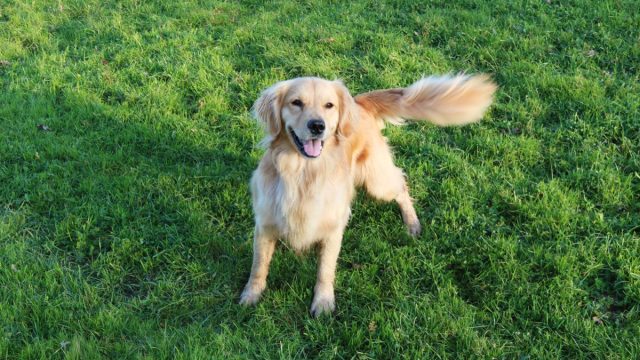Your Dog’s Tail-Wagging Could Be a Bad Thing—Here’s How to Tell

Maybe your dog barks excitedly when you walk in the door, or they jump and lick you when they want to play. In many of these instances where your four-legged friend is happy, they might also wag their tail. However, new research points to the fact that dogs’ tail wagging isn’t always a good thing, as it found that a dog’s emotions might be directly related to the direction in which their tail wags.
RELATED: How to Tell If Your Dog Is Really a “Genius,” New Study Says.
Published in the journal Biology Letters, a new review article looked at more than 100 studies about why domestic dogs wag their tails, focusing on four different aspects: how tail wagging works, its development, what it’s used for, and how it has evolved.
In speaking with Newsweek, Silvia Leonetti, the review article’s first author and research assistant in comparative bioacoustics at the Max Planck Institute for Psycholinguistics, explained that dogs “seem to use their tails primarily for communication, rather than any other function.” She cited the contrasting examples of cats using their tails for balance and horses using theirs to swat away flies.
But perhaps the most interesting finding from their research is that dogs tend to wag their tails to the right in positive situations—”e.g. when shown their owner or a familiar person,” the article notes—and to the left in situations “that elicit withdrawal,” such as “when shown an unfamiliar, dominant dog or when in aggressive situations.”
Also of note is that dogs may be able to pick up these emotional cues from other dogs. “For example, dogs show more [behavioral] and physiological signs of stress when watching video silhouettes of left-biased wagging dogs compared to right-biased wagging dogs,” the article states.
However, the article also notes that dogs’ levels of the stress hormone cortisol did not directly correlate with the direction in which their tail wagged, pointing to the influence of environmental factors.
“There was a study, for example, that looked at shelter dogs and how the dogs wagged their tails before and after being pet by a human,” explained Taylor Hersh, a co-author of the review article from Oregon State University, in an interview with Science. “Dogs that had been admitted as strays actually had their cortisol levels go down after they had been pet by a shelter volunteer. The dogs that had been surrendered by owners didn’t show that drop. In both cases, the dogs were wagging their tails more when they were being pet, but their stress levels changed differently depending on their life history.”
RELATED: The Real Reason You Should Never Wake a Sleeping Dog, Vet Warns.
In trying to understand how domestic dogs started wagging their tails to show emotion (as opposed to other canines like wolves who barely wag their tails), Leonetti told Science that one hypothesis is “humans consciously or subconsciously selected dogs that were wagging their tails more because we are very attracted to rhythmic stimuli [such as music, or the pounding of a horse’s hooves].”
Another possibility is that humans “were selecting dogs for docility and tameness, but these traits were genetically linked to the tail-wagging behavior,” she said.
But whatever its origins, tail wagging is certainly an important part of the dog-human relationship. There are still gaps, however, in figuring out how exactly it’s been developed and whether or not a dog knows how to control these movements. “We are just scratching the surface,” Andrea Ravignani, a senior author on the study, and evolutionary cognitive scientist of the Sapienza University of Rome, told Newsweek.